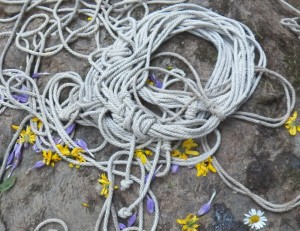Properly caring for you bondage rope will help it have a long and happy life in your toy box. In addition, proper care can ensure that the fibers remain strong and safe for your bondage play.
Note: This guide is a collection of methods practiced by many reputable riggers. It’s not intended to over ride any care instructions that you’ve received from your rope maker.
Storing Your Rope
When storing your rope don’t coil or daisy chain it since this will cause the rope to kink awkwardly. Because Jute and Hemp are bast fibers which are closely related to linen, it has memory. Just like a linen shirt will wrinkle when crumpled in a pile, your rope can kink and it will be hard to get the rope straight again.
Some people suggest that you store your rope hanging over something that’s larger than one inch in diameter. To do this, start with your rope folded in half then fold it in half again and drape it over your closet’s pole or something similar.
If this is not an option some riggers recommend loosely coiling your rope and using twine to bind the coil rather than the rope it’s self.
Still, others recommend making bundles with your rope to store them. However, many riggers don’t bundle their rope until they are preparing for a bondage scene.
Never store your rope in air tight containers. Because Jute and Hemp are natural fibers, they like to breather. Jute is susceptible to mildew when it can’t breathe and Hemp rope will have an unpleasant odor.
Because the sun and heat can degrade the fibers, always store your rope away from direct sunlight.
Cleaning Your Rope
Hemp and Jute rope shouldn’t be washed frequently because the water weakens the fibers and reduce the rope’s strength. Also, the rope swells and stiffens when wet making it near to impossible to untie until it dries. Therefore, clean your rope only when it’s dirty. Otherwise simply let the rope air out.
To remove unwanted body odors, baking soda can be used. However, baking soda will often times remove the natural scent of your rope. In this case, Hemp or Jute Twine placed in your rope bag will help your rope regain its natural smell.
Washing
Hemp and Jute
Place the rope in a pillow case and wash in the washing machine on a normal cycle with cold water and ½ tsp of detergent.
Bamboo and Silk
Wash by hand in the sink with cold water and Woolite. Because Bamboo and Silk fibers are delicate when wet, don’t over agitate, squeeze or wring the rope.
Synthetic Rope
Nylon rope can be run through the washing machine in cold water with a mild detergent. Hang to dry or place in the dryer on low heat.
Drying Natural Fiber Rope
After washing rope it’s important to stretch it to reset the lay and make it even before drying.
Hemp and Jute
Tie one end to a firm object; hold the rope loose end walk the rope out straight. This will take any extra twist out through the rope’s end. After the extra twists are removed slowly pull the rope taunt, then pull an extra stride past taunt. Let the rope return to its length.
Others suggest tying your rope off and allowing it to hang with a cast iron skillet attached to the loose end.
To dry, loosely coil and allow it to air dry away from the sunlight. Another method is to wrap the rope tightly around two fixed points and allow it air dry. For this, the back of wooden chair or chair legs works well. Also weight can be added to the wrapped rope to aid with the stretching process.
Bamboo and Silk Rope
Tie the rope to a firm object and walk the rope out straight while keeping light pressure on it to take out the twists. Slowly pull the rope taunt then allow the rope to return to its desired length and hang to dry.
Conditioning and Oiling Your Rope
Hemp and Jute
Because Hemp and Jute fibers require natural oils to keep them pliable, these ropes can become dry and brittle after washing or over time. Also, Hemp rope will produce dust as you tie it when the rope is too dry.
To bring your rope back to life, oil is needed to condition it. There are many types of natural oils that can be used to treat your rope. Such as pure Mink oil, Hemp oil, Jojoba extract, Bee’s wax, Shea butter, Tsubaki oil or Bayu oil.
The main thing to consider when choosing oil is that vegetable or nut oils are bio degradable and have a tendency to turn rancid or become sticky over time. Always check the label to make sure that your oil is not mixed with this.
After choosing your oil, apply a very small amount to a wash cloth making sure that it’s fully absorbed before oiling the rope. Walk the wash cloth down the length of the rope and let the oil dry for 6-8 hours before applying a second time. After the second application, many suggest allowing your rope to air dry for 48 hours to make sure that the oil spreads evenly throughout the rope and dries completely before storing.
Never apply oil directly to the rope, since this will over cause your rope to be over oiled and feel heavy.
For conditioning Jute Rope it’s recommended to lightly pull the rope over a block of beeswax after oiling.
Bamboo or Silk
If your rope feels dusty or brittle, apply a small amount of your oil to a cloth and pull the rope through.











![e[lust]](/wp-content/uploads/2013/08/elustbutton200-2.jpg)









 Twitter
Twitter Facebook
Facebook
I prefer using a dishwasher > no tangles
PS Here’s a video from my tutorial DVD’s on rope care & treatment: http://esinem.com/portfolio/rope-treatment